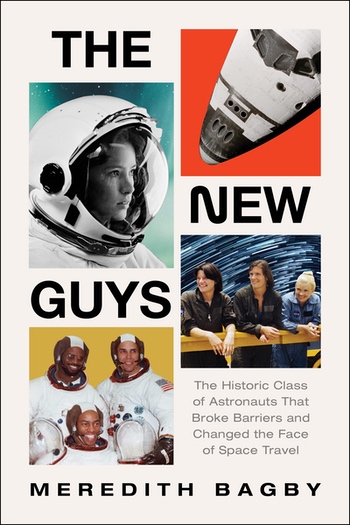 |
Review: The New Guys
by Jeff Foust
Monday, February 6, 2023
The New Guys: The Historic Class of Astronauts That Broke Barriers and Changed the Face of Space Travel
by Meredith Bagby
William Morrow, 2023
hardcover, 528 pp.
ISBN 978-0-06-314197-1
US$40
Other than perhaps the original Mercury Seven astronauts, no astronaut class was more influential than what NASA formally called Group 8, announced in 1978. Until that group, nearly all of NASA’s astronauts were pilots with military experience; all were white men. The 35 members of Group 8—dubbed TFNG for “Thirty-Five New Guys” (with a more explicit alternative)—included the first women and people of color, as well as many more researchers and doctors, as reflecting changing expectations for the spaceflight with the impending introduction of the shuttle as well as a desire, if not an imperative, to have the astronaut corps be more representative of society.
The new book The New Guys by Meredith Bagby examines that historical astronaut class. Given the class’s size, it is not an exhaustive biographical account of every member of the class. Instead, she focuses primarily on those historic members who would become the first female, Black, and Asian American astronauts to go to space.
| When reading the book, one wonders if it had been written with one eye towards turning it into a dramatic series for HBO or Netflix; a For All Mankind about real astronauts. |
The book profiles several of those TFNG astronauts, filling in their life stories as Bagby recounts their decision to apply to become astronauts, the selection and training process, and ultimately flying to space. This is all told against the backdrop of the development of the shuttle program and its problems that would tragically culminate in the Challenger accident; four of the seven people killed were members of that class.
Bagby relies heavily on interviews she performed as well as NASA oral histories and other accounts. The book is filled with passages with reconstructed dialogue from events likely recalled only decades later, along with what she describes in an author’s note as “interior thoughts and feelings” of these people based on her research. “In these cases, I have interpreted how these individuals likely may have thought and felt and represented those thoughts, feelings, and reactions in italics,” she writes. “They have been included to attempt to capture the joy, fear, sorrow, confusion, and excitement felt all throughout the shuttle’s storied history.”
Those thoughts and dialogue do liven up the book, reminding us that these historic astronauts were human beings. It’s unevenly applied, though, as we don’t get the same treatment for most of the other members of the class, including the white male military pilots that would have fit in to earlier astronaut classes. That’s true even among the trailblazing members: while the other five female members of the TFNG are profiled early in the book, we read little about Shannon Lucid until late in the book, when Bagby recounts her extended stay on the Mir space station in the mid-1990s.
That approach does provide the book with dramatic flair. When reading it, one wonders if it had been written with one eye towards turning it into a dramatic series for HBO or Netflix; a For All Mankind about real astronauts.
However, it doesn’t necessarily offer significant new historical insights or revelations about the astronaut class. The book, for example, examines Ride’s same-sex relationships that were not publicly known until after her death in 2012, as well as her behind-the-scenes role in the Rogers Commission investigation of the Challenger accident, but those have been previously reported, including in Lynn Sherr’s excellent biography of Ride (see “Review: Sally Ride”, The Space Review, June 16, 2014).
The New Guys does offer a big-picture view of an astronaut class that reshaped the agency. Recent astronaut classes have approached or achieved gender parity along with greater diversity. They have gone through the door opened, if not built, by the TFNGs.
Note: we are using a new commenting system, which may require you to create a new account.
No comments:
Post a Comment